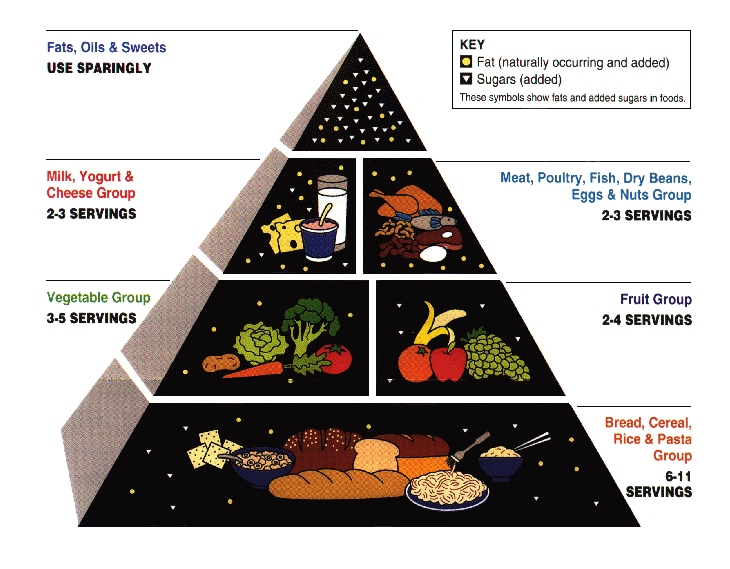Follow The Money - Why Do We Have The Food Pyramid?
How do y'all know what food is healthy? Do you read the nutrition facts looking for calories, sugar, or fat content? Do yous look for government-canonical labeling, certifying the particular as organic or not-GMO? For nigh Americans, their agreement of what is "healthy nutrient" comes straight from Uncle Sam's nutrient pyramid.
There are 1,000s of nutrient products that won't be right for you
Permit GreenChoice find the ones that are
Tell us your dietary needs & values and we'll prove yous foods that match!


Nuts of the USDA Nutrient Pyramid
Born in 1984, the USDA'due south five food groups laid the foundation for the USDA Food Guide Pyramid – first published in 1992 and revamped in 2005. In 2011, the USDA replaced the food pyramid, then known as MyPyramid, with MyPlate (1). Every five years, the USDA releases a new set of Dietary Guidelines, and for nearly xx years, the food pyramid was the symbol of these guidelines.
The USDA Dietary Guidelines feed the content of nutritional posters in schools nationwide, influence public school tiffin programs, institute standards for food nutrition labels, inform nutritional health class curriculums, and guide doctors' dietary recommendations to patients (2).

With such broad influence, it's no surprise that the USDA Dietary Guidelines frequently undergo careful scrutiny and have been quite controversial over the years.
For example, throughout the late twentieth century, the USDA's Nutrient Pyramid made fat content the devil, pitting information technology as the crusade of heart illness and cancer (three). However, many nutritionists and food scientists at present paint a unlike film, claiming that a diet rich in refined carbohydrates, often synonymous with the base of operations of the Nutrient Pyramid, brings more than people to the infirmary.
Since 1980, when the USDA issued its starting time Dietary Guidelines, the number of Americans who are obese or take blazon ii diabetes has more than than doubled (iv, five).
The Food Pyramid vs. food manufacture lobbying
We're taught that good for you food is depression in sugar and calories, that we demand carbs from grains, calcium from milk, and poly peptide from meat, but the reality of "healthy food" is much more complicated than information technology seems.
In 2010, the Supreme Court released a ruling in a landmark case, Citizens United v. FEC. This case dealt with the intersection of the First Subpoena and corporate spending, concluding that "corporate personhood" applies in the context of free voice communication. For a long fourth dimension, the U.S. government didn't permit corporations to spend money on political campaigns in an endeavour to subtract the risk of corruption. Notwithstanding, the Citizens United ruling gave corporations the liberty to contribute money to political campaigns furthering their calendar. Equally a result, lobbying efforts past large food and beverage producers and brands keep their interests embedded within public food and health policy.
With significant power over legislation, major food and beverage companies take a huge influence on what gets published in the USDA's Dietary Guidelines, and subsequently, what the Food Pyramid looks like.
Concluding year, 237 clients lobbied the nutrient manufacture, releasing 933 reports (six). In 2015, every bit the USDA was releasing its 2015-2020 Dietary Guidelines, 255 clients lobbied the food industry, releasing 1,176 reports (7). Some of the lobbyists' largest clients come as no surprise and include the likes of PepsiCo, Coca-Cola, Monsanto, Nestle, and McDonald's, to name a few. When dealing with massive multi-national corporations such as these, you can be certain that large sums of cash are involved. So, how much does the food manufacture spend lobbying U.S. food policy and regulation?
In 2015, Coca-Cola alone spent $8.67 million on lobbying, the meat processing and product industry spent $iv.58 meg, the dairy industry spent $7.12M, and the food products manufacturing industry spent a whopping $18.83 million (8, 9, ten, 11).
The USDA Dietary Guidelines testify that money, power, and politics feed America's obesity and chronic disease epidemic ( 12 , xiii ).
2020 USDA Dietary Guidelines fall short
With the meat and beverage industries deploying such big sums of lobbying dollars, information technology is no coincidence that the 2015-2020 USDA Dietary Guidelines downplay some important facts, compromising our nation'south health in order to appease some of America's largest food producers.
While the guidelines clearly state the importance of reducing dietary saturated fat, added sugar, and sodium in their executive summary, they exit out a disquisitional detail — the main sources of these nutrients (14).
For case, information technology isn't until the reader takes a deep dive into the belly of the guidelines that they discover consuming less red and processed meat tin significantly decrease one's risk of obesity, heart illness, type ii diabetes, and sure cancers. Fifty-fifty then, the document is written towards nutritionists and wellness professionals, making it difficult for the average American to understand, let alone interpret correctly and apply to their daily food and drink choices.
USDA'due south MyPlate vs. Harvard'southward Healthy Eating Plate
Besides offer vague and indirect data, the hit difference betwixt the USDA guidelines and other wellness authorities' may also bespeak to industry influence, particularly in the case of dairy.

The USDA recommends most people should swallow iii servings of dairy daily, while the Harvard School of Public Health recommends limiting dairy to merely i to 2 servings per twenty-four hours (fifteen, 16). Harvard cites there is little evidence to suggest dairy is essential for wellness, still there is "considerable evidence" that too loftier a dairy intake can be harmful (17, 18).
The stark disparity between the USDA's and Harvard's recommendations for dairy illustrates the influence food manufacture lobbyists have on our perception of what is "healthy."
USDA Guidelines overlook food sustainability
Furthermore, the USDA completely axed sustainability considerations from the Dietary Guidelines despite its own Advisory Committee recommending food system sustainability be incorporated into the dietary recommendations (19). Sustainable farming, herding, and manufacturing processes are ones that preserve resources and accept minimal impact on the environment. Eating sustainably attained nutrient, such as crops grown without toxic pesticides or pasture-raised cattle, is generally better for the planet (20, 21).
The USDA's Dietary Guidelines point our wellness and the surround come up 2nd to the deep pockets of a small grouping of turn a profit-driven corporations that control America'due south industrialized nutrient system.
The Food Pyramid and America's health epidemic
Why does the food pyramid thing? The heavy paw that major food and drink companies take on the USDA's Dietary Guidelines is securely disturbing when you lot consider the influence they have on America'due south understanding of what is a "good for you diet."
Despite billions of dollars invested in healthcare and medical research annually, childhood obesity is on the rise, the prevalence of blazon two diabetes is college than e'er, and heart affliction is the leading cause of decease, killing 647,000 Americans every year ( 22 , 23 , 24 ). Information technology'due south hard not to wonder how much of our nation'southward decaying health is a product of the charade fueled past big food and ag spending and amplified past the U.South. food pyramid.
If there's 1 matter that the U.S. food pyramid teaches united states, it's that the truth is in the details and that the details are complicated. Withal, hope for a healthy America is not lost. There are a growing number of unbiased organizations working to simplify diet and help the American people make healthy food choices.
At that place are i,000s of food products that won't be right for you
Let GreenChoice detect the ones that are
Tell united states of america your dietary needs & values and we'll evidence yous foods that match!


***
Editor's Note: This post was originally published on September 17, 2017, and has been revamped and updated for accuracy and comprehensiveness.
GreenChoice, pbc is a climate-positive market for conscious consumers with dietary needs. Shop over 10,000 natural & organic nutrient items, with 90+ dietary filters and GreenScore ratings–color-coded health & climate ratings, that turn hours of inquiry into seconds. We evangelize to your door in three-5 days and offset 2x the carbon footprint of your entire order–products, packaging, and shipping.
Source: https://www.greenchoicenow.com/v/food-pyramid-usda-dietary-guidelines
Posted by: williamsbrat1966.blogspot.com

0 Response to "Follow The Money - Why Do We Have The Food Pyramid?"
Post a Comment